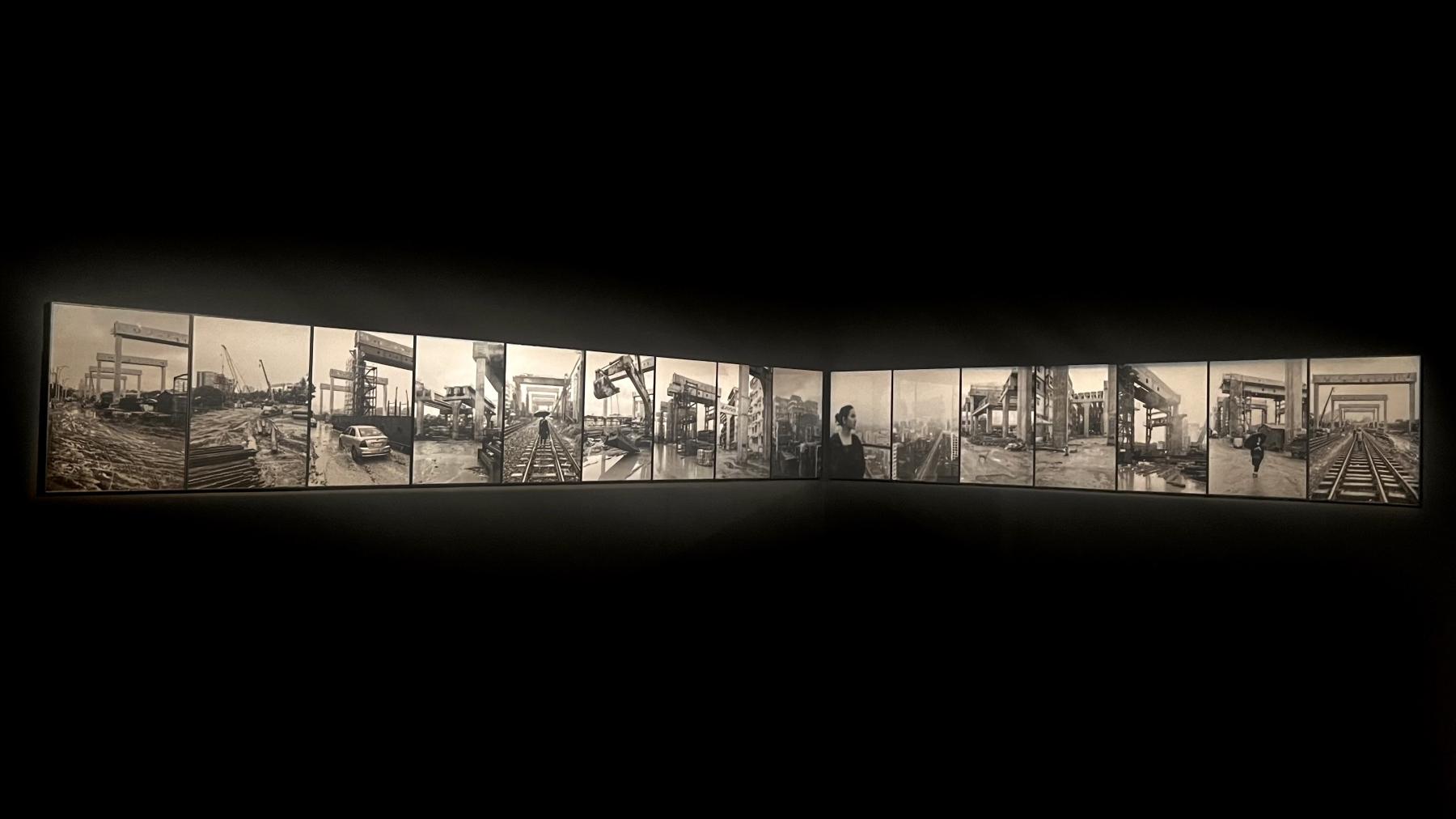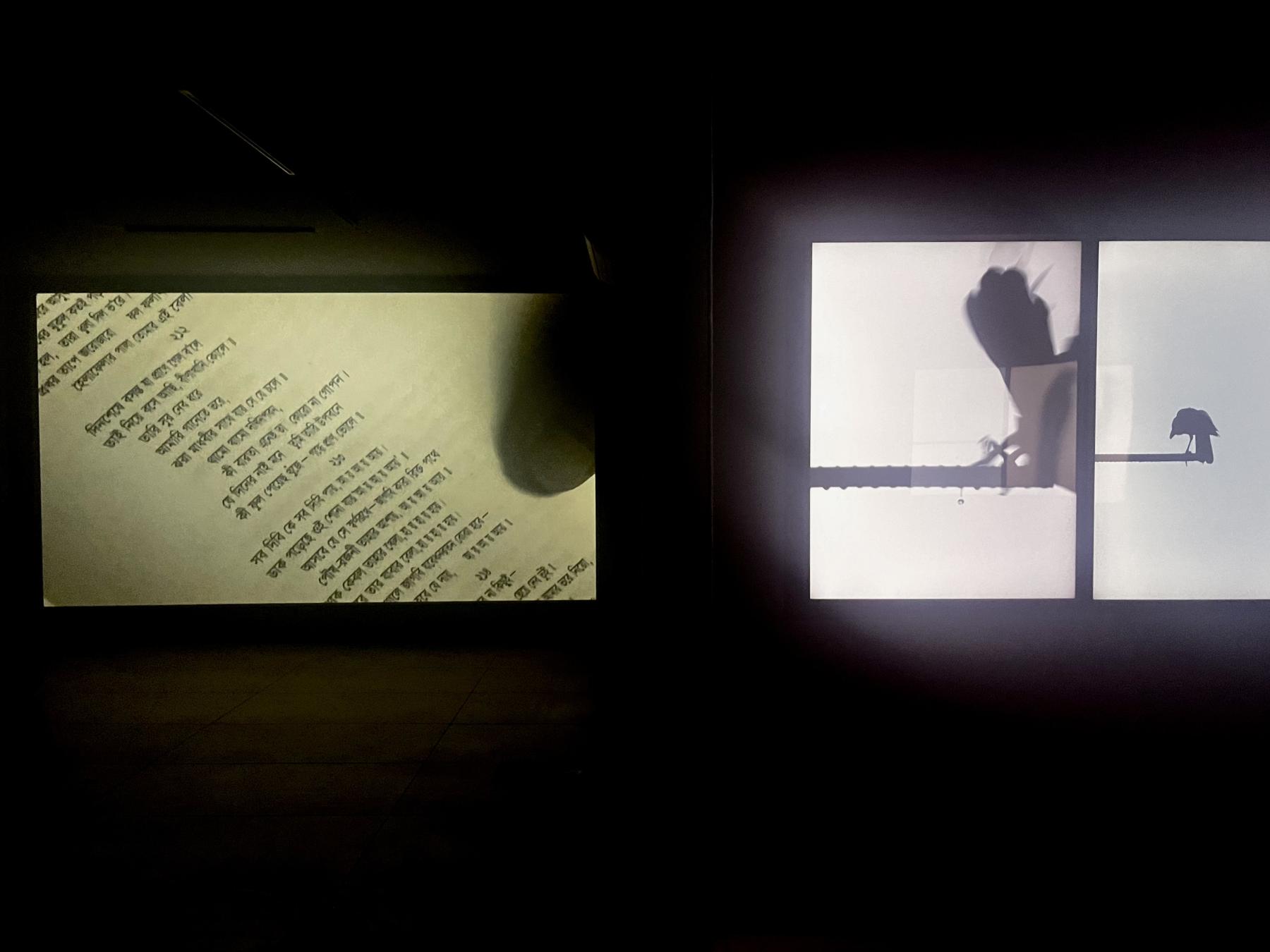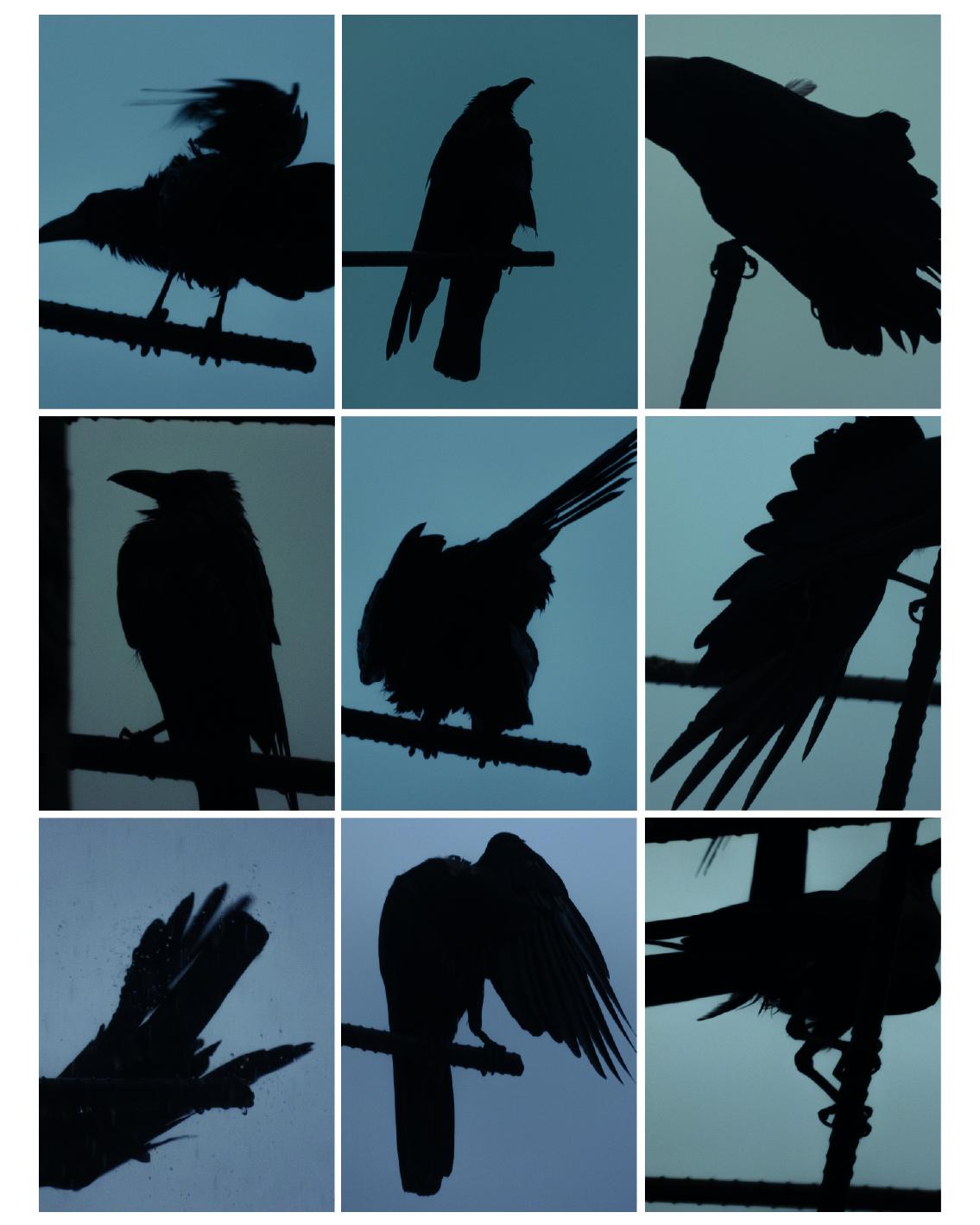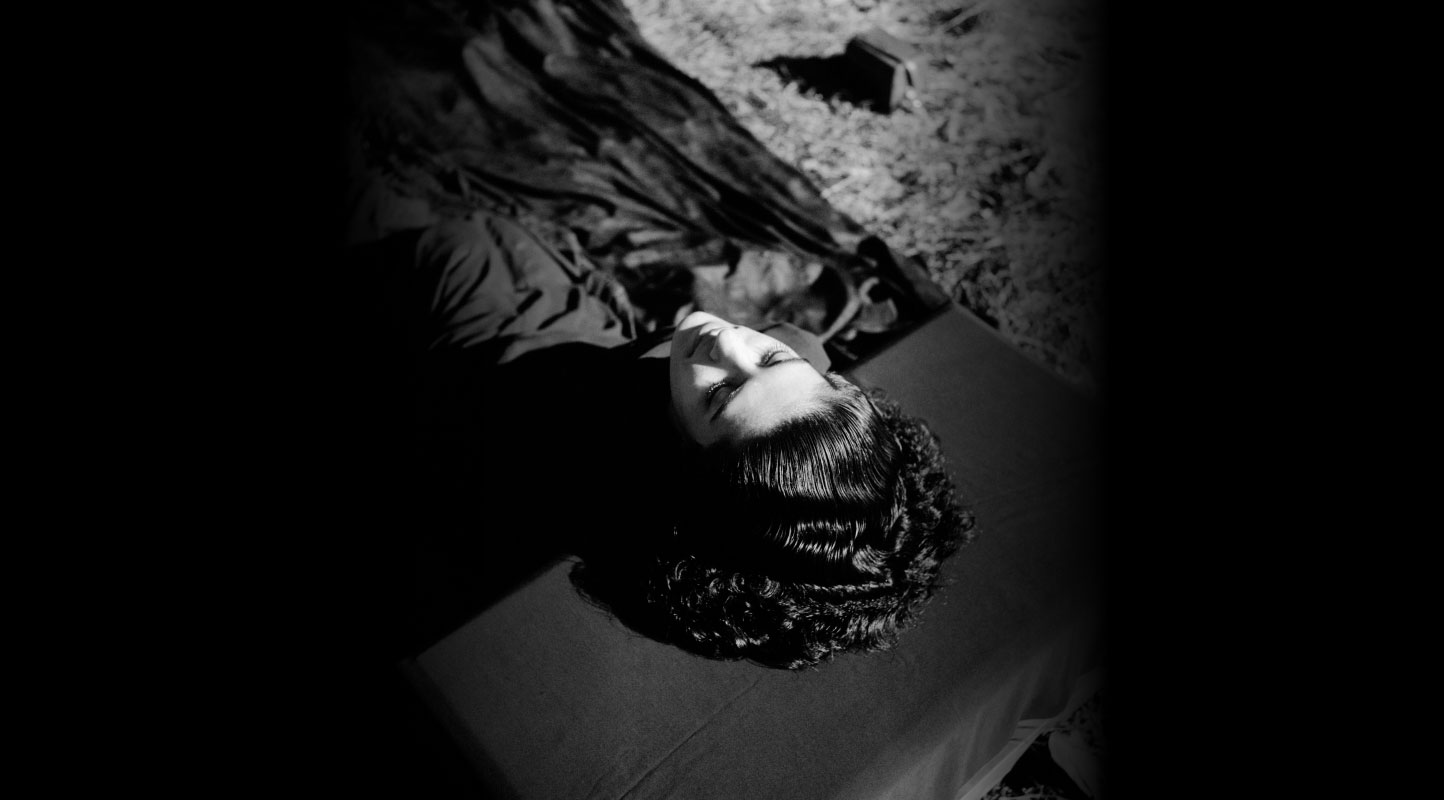It Feels Like Flight: Sarker Protick’s Akash Kalo Megh
“In a field
I am the absence
of field.
This is
always the case.
Wherever I am
I am what is missing.”
American poet Mark Strand, in his poem “Keeping Things Whole,” wrote pensively of what it means to build entireties in the presence of an elsewhere, an emptiness that could arrive at any moment. How we move to sustain that which sustains us—home, family, identity, land—defines in so many ways the method and metaphor of our lives. Reflecting on the absence that permeates our sense of self and place, Sarker Protick’s Akash Kalo Megh explored the blur of inner and outer landscapes, tracing the weight of how we remember—in its different, distended forms within us.

Installation view of Akash Kalo Megh (2025. Image courtesy of the author.)
Presented by Shrine Empire, Akash Kalo Megh (Shadows in the Sky) was Dhaka-based Protick’s second solo exhibition, on view in conjunction with the India Art Fair. Spanning multiple bodies of work, the exhibition unfolded as a singular, seamless experience—an invitation to see through the artist’s eyes. In Akash Kalo Megh, Protick’s images rendered a city of belonging through the verb of incompletion. Dhaka—capital, centre, home—holds familiarity and change in shifting degrees of separation, both house and host at once.

Installation view of Stitched / আকাশ কালা মঘ / Shadows in the sky (2023. Single Channel Video, B/W, 26:30 minutes, stereo sound. Edition of 3 + 1 AP. Image courtesy of the author.)
The familiar is traced through the shifting outlines of his mother Bina’s many selves in Stitched (2023), a single-channel video where Protick captures her presence ever so gently in light and rain. As both title and impulse, Stitched reflects a process of bringing together glimpses of home and belonging. In the quiet constancy of his mother’s presence, Protick finds an anchor—not only for the exhibition space itself but also for the other works within it. Bina is pictured as she moves through her space, her writing and her songs, and Protick witnesses her—against the rain, in between frames—always with immense love. Mother and city fold into each other in his gaze, mantled in a tapestry that to him is at once obvious and beloved, a passage through Protick’s process of image-making itself. Stitched does not ask to be deciphered; it asks only to be witnessed, to be seen in its quiet vacillations. Where one begins and the other ends is no longer relevant—perhaps it never was.
.jpg)
From the series Murder (2020–21. Lightbox, 40 x 30 inches. Edition of 5 + 2 AP.)
Birds are a way to write about loneliness. Often, they evoke solitude and distance—sometimes, their wings spell longing, departure and the possibility of return. Murder (2020–21), a series of striking lightboxes, directed the exhibitory experience of the works, each image capturing the crows mid-metamorphosis, suspended between form and transformation. As a visitor, you are led by the crows’ light, by their illuminations—theatrical, almost operatic gestures in the darkness. But here, the crows are not ominous, and they do not portend. Instead, they are friendships—companions to the city and its towering nests, to Protick’s mother and the spaces they share, flitting across routine and domesticity. Their gathering presents itself as an offering, a silent kinship. The lightboxes punctuate the space, weaving a fractured, beckoning continuity between the rooms.
From the series Scaffolds and Tracks (2024—ongoing. Inkjet Prints,17.5 X 12.5 inches each, set of 6. Edition of 5 + 2 AP.)
In Scaffolds and Tracks, a series of photographs, Protick traces the outline of the city he calls home, fleshing out the contours of its skyline with the relationships that hold him close. How do we chart ‘ritual’—our everyday cartographies—against disintegration? Protick’s lens turns toward Dhaka—the city drenched, its pillars and cranes leaning to the sky, its people moving through uncertainty, perpetuating life as they always have.
From the series Scaffolds and Tracks (2024—ongoing. Inkjet Prints,17.5 X 12.5 inches each, set of 6. Edition of 5 + 2 AP.)
Like most cities, Dhaka has a language that has little to do with the spoken or written word. Instead, this language—its skeletal substructure—is stretched and shaped by the limbs and bodies that carry it. Here, scaffolds and tracks act as punctuations in this language—things that hold other things up—and through these photographs of his own neighbourhood, Protick annotates his familiarity with care. To picture what we know too well is to produce a different kind of affect than when we encounter something for the first time. There is more sentiment, and we become guarded about the meanings we allow in. In Protick’s photographs, we witness this relationship—reflected in open pools of rainwater and in the curve of roads lifting into buildings.
A welcome addition to navigating the exhibition, Arushi Vats’ texts wove poetic insertions into the space, unfolding alongside the works and enveloping the viewer in verse and its possibilities. With great sensitivity, they attuned one to the many nuances of Protick’s work, conversing with and reading his images as one might read a poem—closely, intuitively and with care.
From the series Scaffolds and Tracks (2024—ongoing. Inkjet Prints,17.5 X 12.5 inches each, set of 6. Edition of 5 + 2 AP.)
In a city, the open sky is an affordance. Across the composite parts of Akash Kalo Megh, the image of the sky becomes a letter to its inordinacy. Protick moves away from placid blues and into richer greys, into wetter seasons and deeper relationships, making us more than viewers—confidantes in this homecoming. His images trace the ways in which progress or development continues to be misspelled, the ways in which these misspellings shape the landscape. And yet, the act of making the unfamiliar familiar is what eventually defines the everyday as it is performed. More than an accepted reality, the everyday—experienced by different people, across different lives—is a performance in itself.

Installation view of Akash Kalo Megh (2025. Image courtesy of the author.)
Upon a closer look, Protick’s images hold certain motifs to which he returns, almost lyrically. The train echoes in the video, its silhouette appearing in fragments across photographs of his neighbourhood; the rain repeats, in sound and in his visual diaries; his mother emerges as a poem in vignettes, narrated verse by verse. These motifs—repetitions, the same journey taken over and over—become a study of our orbital ways of being. They are akin to the minutiae we reread every day, tracing the rhythms of memory, movement and belonging that shape our lexicons—our languages of the self.

From the series Murder (2020–21. Lightbox, 40 x 30 inches. Edition of 5 + 2 AP.)
To learn more about Sarker Protick’s work, revisit the episode of In Person in which the artist and curator presents a walkthrough of his exhibition Nirbodhi/Time Stands Still (2022) as well as Veerangana Solanki’s two-part conversation with the artist about his Time Trilogy and on his light and sound installations.
All works from Akash Kalo Megh (2025) by Sarker Protick. Images courtesy of the artist unless otherwise mentioned.




